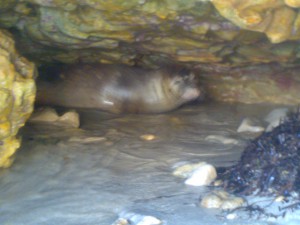— Giuseppe Notarbartolo di Sciara, Tethys Research Institute, Milano, Italy
— Mahmoud Fouad, Egyptian Environmental Affairs Agency, Cairo, Egypt

On 7 April, during a recent trip along Egypt’s Mediterranean coast to establish stakeholder contacts in implementing a National Action Plan for the Conservation of Cetaceans in that country, funded by the Regional Activity Centre for Specially Protected Areas (RAC/SPA) of Tunis, we were informed by the local community of Marsa Matrouh of a spate of monk seal sightings in the area. The news had generated considerable excitement, since the species has long been considered extinct in Egypt.
In a meeting at the offices of the Director of Environmental Affairs of the Marsa Matrouh Governorate, fishermen reported that seals had been observed several times during the previous 10 days. Mr. Abd El Malek in particular, a fisherman about 60 years old, was very clear. He had begun noticing that something was pulling fish out of his trammel nets, “in a very professional way”, i.e. without breaking the mesh. His boys had told him that they had seen a very strange animal around the nets, similar to those they had watched on TV, in the “yellow square” (National Geographic) eating penguins under the ice. At first he didn’t believe them: throughout his life, he’d never seen a seal in these waters; other fishermen said the same. After several attempts, however, they indeed caught a glimpse of a seal resting on one of the small sandy beaches along the local rocky coastline, and managed to take a few pictures and even a short video with their cell phones. Other fishermen agreed, asserting that they had frequently seen up to five seals during the same period, in a location about 5 km away from the first, and that their nets had been completely destroyed.

While we consider this last snippet of information unsubstantiated and rather unlikely, the documentation provided by Abd El Malek leaves no doubt that at least one monk seal had made its appearance in Egypt, more than 20 years after the species was last reported from the country. Based on a very preliminary assessment, it seems quite possible that both photographs and the video are of the same seal, and we can thus only be certain about the presence of that one individual. Unfortunately, we also heard rumours that one seal had been killed — which, if true, might mean that this recent monk seal foray into Egypt ended abruptly in tragedy.
What might have led a monk seal to visit Egypt again after so many years of absence is open to speculation: natural dispersion from adjacent remaining concentration areas, war-induced dislodegment from Cyrenaica – a putative, yet unconfirmed area of occupancy – are all possible explanations, hopefully to be confirmed by future sightings. Certainly, a careful preparatory work, largely based on local awareness and involvement campaigns, is now needed to ensure that the area may eventually be recolonized by monk seals. To that end, the ongoing effort to conserve cetaceans in the area has quickly been renamed the National Action Plan for the Conservation of Marine Mammals in the Egyptian Mediterranean.
Qism Moursy Matrouh, Matrouh, Egypt

this is great news… species which has been considered extinct… great work Ministry of Environment, protection, high protection is needed.